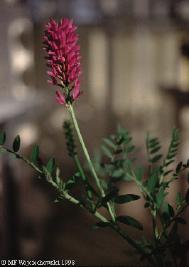

Common Name:Great
Wall Astragalus, or Sha Da Wang (flower that grows in desert)
Genus: Astragalus
Species: adsurgens
Parts Used: the whole plant

Milkvetch is a perennial found throughout northern and southwestern China and northern North America. It is a perfect plant for cold, and arid to semi-arid regions with poor or saline soils. It has a very long tap root and can get water deep in the ground. In China it is grown as fodder, green manure and for soil conservation. Milk vetches are part of the bean family (Fabaceae). In Latin, fab means "bean".
Each plant has a couple of stems that can grow to be 1.5 to 2 m tall. The leaves are each composed of 9 to 19 narrow leaflets, and are about 2 to 4 inches long with soft hair all over them. The main tap root is thick and has many roots growing off it. A secondary root system starts about 20cm. under the ground and can reach out to about 150 cm in diameter. Nodules develop on the roots closer to the surface from which new plants grow.
Milkvetch flowers thoughout August. The lavender or bluish-purple flowers are about 1/2 inch long and arranged in a dense cluster. The cluster grows on a short stalk and can be cylindrical and about 3 inches long. Seeds grow in a small, hairy pods that turn black. The seeds are small and black and sometimes rattle in the pod, giving some species of this plant the name Rattle Pod.
One species of Astragalus, Astragalus lentiginosus, contain the alkaloid swainsonine, which can cause locoism. When animals eat this astragalus their nervous systems become impaired, and they become very excited when disturbed. Sometimes they died. In the old days it used to be known as "loco weed".
A less deadly variety of vetch can be found growing along our country's highways as soil erosion control. In the spring the blue flowers of vetch will carpet the sides of roads from New Enland to California.
2000
Bibliography:
"Astragalus adsurgens (Lavender Milk-vetch)", http://www.npwrc.usgs.gov/resource/literatr/wildflwr/species/astradsu. htm